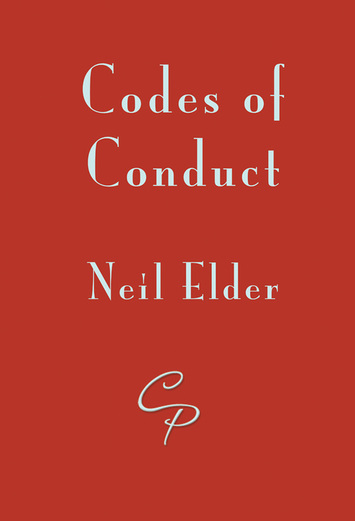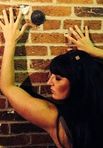Carpe Noctem Chapbook Interview With Neil Elder
 Cinnamon Press, 2015 THINGS WE’RE DYING TO KNOW…
Cinnamon Press, 2015 THINGS WE’RE DYING TO KNOW…Let’s start with the book’s title and your cover image. How did you choose each? And, if I asked you to describe or sum up your book, what three words immediately come to mind?
Primarily the collection explores the gap between what we think we know and what we actually know about other people. The title, Codes of Conduct emphasizes the idea that runs through the collection that we are all expected to behave in certain ways. Those patterns of behavior, the conventions that exist in society, come from all aspects of life – from family and loved ones, from ourselves and from the world of work or whatever roles we are fulfilling. We expect certain actions and thoughts from others, because by and large we are conventional. The cover is part of the Cinnamon Press house-style for the pamphlets that win their pamphlet competition.
What were you trying to achieve with your collection? Tell us about the world you were trying to create, and who lives in it.
Wow, that wants a long and involved response that shifts whenever I consider such things. My main concern is to explore the difference between what we think we know about people and what we actually know about them. I say in readings that people may look at their colleagues differently tomorrow, but the poems could just as easily be asking what you think you know about your neighbour and what you actually know about them – or even what you really know about your husband/wife, or perhaps yourself!
The pamphlet divides into two parts; the first part is a sequence that concerns a figure called Henderson and his world of work, the second half are stand-alone poems, that develop notions about how we communicate. Across the first half Henderson and some of his colleagues filter in and out of the poems. The poems cast a wry look at work and the ridiculous aspects of it, such as jargon and the notion that setting targets makes people more effective. At work there are perhaps certain assumptions made about people based on their role but these often miss what an individual is really like.
Through the character of Henderson I challenge the idea that getting to the top is what we all want. In the second half of the book some of the big themes – relationships, death, parenthood get an airing – you can’t have a book of poems without love and death, can you?The poems combine sharply observed humour and pathos; which seems to me to be what life contains.
Can you describe your writing practice or process for this collection? Do you have a favorite revision strategy?
The catalyst for half the collection is a poem called "Restructuring," which effectively points out the weasel ways and words of management, when euphemisms are used to try and soften something that is actually pretty painful and brutal. In this poem, which is set in an office, I suggest the lives and characters of some of the employees. I think this was the first time I really discovered the freedom and flexibility offered by employing characters; there is a touch of the fiction writer involved in this. I then managed "Open-Plan," which is the first poem in Codes of Conduct and which firmly establishes the disconnect between our assumptions about people and the reality. In this poem, Henderson, seemingly a straight-forward office worker, is revealed as having quite a daring and exciting side to his life away from work. I wanted to know more about Henderson and he stuck in my head and I worked on him. At some point I had perhaps three or four Henderson poems and an editor, who saw these poems, asked if there was going to be a longer sequence. I didn’t know how many I’d write, but I ended up with fifteen. What I did find was that once I had the setting, then scenarios suggested themselves: someone retires, someone has a birthday, there is a fire alarm. Thus I had a firm scaffold upon which to build and I never felt like I was starting from scratch – there was enough of a pre-existing landscape to feel I had some momentum.
Meanwhile I would be writing other pieces, away from Henderson. These pieces were slower to come because I didn’t have the framework. However, I did find that ideas about identity and how we communicate were clearly coming through, just as they do in the Henderson pieces.
The revision of the poems is fairly constant – that thing of a poem is never finished, merely abandoned. I start with handwritten drafts and when I feel a poem has some chance of working I move to typing it up. That can alter line endings and all sorts. I then print off the draft, and more tinkering will happen. Some of the poems have been part of workshops I regularly attend with a group – people stamp on the poems and I work with what’s left!
How did you order the poems in the collection? Do you have a specific method for arranging your poems or is it sort of haphazard, like you lay the pages out on the floor and see what order you pick them back up in?
It is possible for the Henderson poems to be read as individual pieces and in any order, but there are some elements that suggest a narrative arc; those elements were the ones that dictated the order in the first half. Part two of ‘Codes of Conduct’ has the pace, length and tone of the poems in mind. I have seen photographs of poems laid across the floor as a means of finding a structure to a collection. I suppose that can work, but the irony is that most people read collections of poetry in their own order, dipping in and out – that’s one of the joys of reading poetry. However, I suppose that listening to Sgt. Pepper on shuffle must be detrimental to the whole work, and so we should perhaps be more willing to start at page one of a poetry collection and read on until the end.
What do you love to find in a poem you read, or love to craft into a poem you’re writing?
The things in poetry I like to read, and in the poems I hope to write, are a surprising turn of phrase, an original image or way of seeing things. I am not a huge fan of deliberately obscure clever-clever poetry, and so I suppose a certain immediacy is what I want. In Codes of Conduct I think I have the familiarity that makes people smile and nod as they read, but also I pin ideas with a particular phrase or present something from a side-long view that offers the element of surprise or keeps things feeling new.
6. Can you share an excerpt from your book? And tell us why you chose this poem for us to read – did it galvanize the writing of the rest of the collection? Is it your book’s heart? Is it the first or last poem you wrote for the book?
The poem I am providing here, "On The Floor," comes from the second half of the collection, and perhaps captures the humour of the pamphlet, but also clearly has communication and our understanding of each other at its heart. I wondered about using the first Henderson poem, but I have had a good reaction to ‘On the Floor’ and at readings I tend to open with it. There certainly seems to be something in the poem that people identify with – that mix of desperation and frustration – feeling misunderstood and not quite knowing how to communicate ideas to others. This poem first appeared in the lovely magazine ‘The Interpreter’s House’.
On the Floor
I would like to lie down on the kitchen floor
and howl like a dog.
What stops me is the thought
that if you walk in just as I let out a yell,
all sorts of awkward questions may be asked.
But then again, perhaps I am mistaken
in judging your reaction
to this scene -
maybe you will join me,
primal, foetal, brittle
and take your place upon the Lino
so that we can tell each other
exactly how we feel.
If you had to convince someone walking by you in the park to read your book right then and there, what would you say?
That Codes of Conduct will have thoughts and ideas that they have had, possibly without even realising. That there will be a response and recognition on an emotional level to the poems. That the work is very accessible and not hearts and flowers or obtuse. And that they will find themselves laughing – that’s got to be good.
For you, what is it to be a poet? What scares you most about being a writer? Gives you the most pleasure?
In many ways I think writing poetry is my equivalent to crosswords or Sudoko and such things that other people do to keep the mind active. There is also a level of challenge – “Okay, I’ve got half an idea, or I’ve got an opening line – now can I make it a decent poem?” There is also the more elusive aspect whereby I perhaps find it cathartic to write about something, but I don’t tend to set about the task in such an obvious fashion. I suppose the fear is that nothing else will come to me, or if it does it will be no good. I think perhaps the ‘correct’ answer concerning pleasure is that the act of writing itself is rewarding, and that is true, but knowing people have read and enjoyed my work is pleasing. Of course the pleasure comes in people saying nice things, but more than that I find the notion that I have made them see something in a new light or from a different angle particularly rewarding – that is often in the quiet nod of a reader, though of course I’m rarely around when they actually read my stuff (that would be weird!).
Are there other types of writing (dictionaries, romance novels, comics, science textbooks, etc.) that help you to write poetry?
Nothing consciously triggers my poetic reflex but I do read a lot of poetry and that percolates somewhere in the mind.
What are you working on now?
A large part of me hopes I don’t know what’s coming next – I want the line to strike me in a lightbulb moment, but things don’t work like that usually. I have a sequence up and running that involves a couple of young women, Ellie and Tara, and through them I suppose I am making observations on life, in particular the way we look at each other – ‘look’ in all dimensions, I mean.
What book are you reading that we should also be reading?
They Came Like Swallows by William Maxwell. He writes such beautiful prose and captures the sense of things, the mood and feelings in the air, without pushing so hard that the spell gets broken. The inner-thoughts and private lives of characters are so wonderfully explored. Pretty much any William Maxwell should be in your house, but this is so delicate it needs to be treasured.
Without stopping to think, write a list of five poets whose work you would tattoo on your body, or at least write in permanent marker on your clothing, to take with you at all times.
Edward Thomas, Paul Farley, Lorraine Mariner, Andrew Motion, Philp Larkin
13. What’s a question you wish I asked? (And how would you answer it?)
Any tips for budding poets? – Join a writing group/workshop – the constructive advice of trusted others is invaluable.
***
Purchase Codes of Conduct from Cinnamon Press.
 Neil Elder has had poems published in various magazines and journals, among them are The Rialto, Prole, Acumen, The Interpreter’s House. In 2015 Neil won the Cinnamon Press Pamphlet completion with ‘Codes of Conduct’. Neil lives and works in N.W London. He is a member of Herga Poets and enjoys giving readings. Read Neil’s blog and some of his poems here https://neilelderpoetry.wordpress.com.
Neil Elder has had poems published in various magazines and journals, among them are The Rialto, Prole, Acumen, The Interpreter’s House. In 2015 Neil won the Cinnamon Press Pamphlet completion with ‘Codes of Conduct’. Neil lives and works in N.W London. He is a member of Herga Poets and enjoys giving readings. Read Neil’s blog and some of his poems here https://neilelderpoetry.wordpress.com.
Published on June 08, 2016 13:54
No comments have been added yet.



